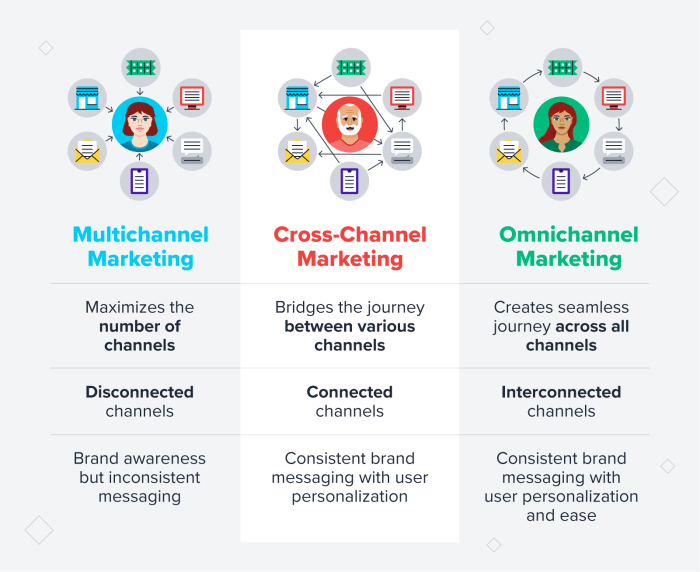Developing a Multi-Channel Marketing Plan takes center stage, this opening passage beckons readers with american high school hip style into a world crafted with good knowledge, ensuring a reading experience that is both absorbing and distinctly original.
When it comes to marketing, having a multi-channel approach is key to reaching customers effectively in today’s digital landscape. This plan involves utilizing various platforms to promote your brand and engage with your audience in different ways, ultimately driving growth and success for your business.
Importance of Multi-Channel Marketing

Multi-channel marketing is like having different flavors in your smoothie – it makes your business stand out and appeal to a wider audience. By utilizing multiple channels such as social media, email, websites, and physical stores, businesses can reach customers wherever they are and in the way they prefer to engage.
Increased Brand Visibility
When you’re everywhere, customers can’t help but notice you. Take Nike, for example. They have a strong presence not only in their physical stores but also online, on social media, and through partnerships with athletes. This multi-channel approach ensures that their brand is always top of mind for consumers.
Enhanced Customer Engagement
Engaging with customers on different platforms allows for a more personalized and interactive experience. Sephora does this well by providing beauty tutorials on YouTube, offering loyalty rewards through their app, and showcasing user-generated content on Instagram. This variety keeps customers engaged and coming back for more.
Developing a Comprehensive Marketing Plan
In order to develop a successful multi-channel marketing plan, there are several key steps that need to be taken into consideration. It’s important to understand the differences between traditional marketing plans and multi-channel marketing plans, as well as how to align marketing goals with multi-channel strategies.
Steps Involved in Developing a Multi-Channel Marketing Plan
- Conduct market research to identify target audience and their preferred channels.
- Set clear and measurable marketing objectives for each channel.
- Create a consistent brand message across all channels.
- Determine the budget allocation for each channel based on ROI projections.
- Implement tracking and analytics to measure the effectiveness of each channel.
- Regularly review and optimize the multi-channel marketing plan based on performance data.
Comparison of Traditional Marketing Plans with Multi-Channel Marketing Plans
- Traditional marketing plans typically focus on one or two channels, such as print or TV ads, while multi-channel marketing plans leverage multiple channels like social media, email, and websites.
- Multi-channel marketing plans allow for greater reach and engagement with customers compared to traditional plans.
- Traditional plans may have a longer turnaround time for campaign execution, whereas multi-channel plans can be implemented more quickly due to digital channels.
Tips for Aligning Marketing Goals with Multi-Channel Strategies, Developing a Multi-Channel Marketing Plan
- Ensure consistency in branding and messaging across all channels to maintain a cohesive customer experience.
- Use data and analytics to track customer behavior and adjust strategies accordingly for each channel.
- Set specific KPIs for each channel to measure success and make data-driven decisions for optimization.
- Regularly communicate and collaborate with team members across different departments to align on goals and strategies.
Identifying Target Audience Across Channels

In today’s digital age, understanding your target audience across various marketing channels is crucial for the success of your multi-channel marketing plan. By knowing their behavior and preferences, you can tailor your content to effectively reach and engage them.
Importance of Understanding Target Audience Behavior
Understanding how your target audience behaves on different channels allows you to optimize your marketing strategies for each platform. This knowledge helps you deliver the right message at the right time, increasing the chances of conversion and building brand loyalty.
Methods for Identifying Target Audience Preferences
1. Conduct surveys and polls to gather insights on consumer preferences and behavior.
2. Analyze data from website analytics, social media insights, and email marketing metrics to understand how your audience interacts with your content.
3.
Utilize customer relationship management (CRM) tools to track customer interactions and preferences across channels.
4. Use A/B testing to experiment with different messages and content formats to see what resonates best with your target audience.
Creating Personalized Content for Different Target Segments
1. Segment your audience based on demographics, behavior, and preferences to create targeted content for each group.
2. Leverage marketing automation tools to deliver personalized messages based on user interactions and interests.
3.
Implement dynamic content that changes based on user behavior and preferences to enhance engagement and conversion rates.
4. Test and optimize your content regularly to ensure it remains relevant and resonates with your target audience across all marketing channels.
Integration of Online and Offline Channels: Developing A Multi-Channel Marketing Plan
In today’s digital age, integrating online and offline marketing channels has become crucial for a successful multi-channel marketing strategy. By combining both online and offline tactics, businesses can reach a wider audience, increase brand visibility, and drive conversions effectively.
Benefits of Integrating Online and Offline Channels
- Increased Brand Awareness: By utilizing both online and offline channels, businesses can create a cohesive brand presence that resonates with customers across different touchpoints.
- Enhanced Customer Engagement: Integrating online and offline channels allows for a more personalized and interactive customer experience, leading to higher engagement and loyalty.
- Improved Tracking and Analytics: By combining online and offline data, businesses can gain a more comprehensive view of customer behavior and preferences, enabling better-informed marketing decisions.
- Optimized Marketing ROI: When online and offline channels work together seamlessly, businesses can maximize their marketing budget and achieve a higher return on investment.
Examples of Successful Campaigns
- Starbucks’ Mobile App: Starbucks effectively integrates its mobile app with its physical stores, allowing customers to order ahead, earn rewards, and pay seamlessly both online and offline.
- Coca-Cola’s Share a Coke Campaign: Coca-Cola’s personalized “Share a Coke” campaign combined online customization with offline product delivery, driving engagement and social sharing.
Challenges and Solutions for Integration
- Challenges: Some challenges businesses face in integrating online and offline channels include data silos, inconsistent messaging, and logistical complexities.
- Solutions: To overcome these challenges, businesses can invest in integrated CRM systems, maintain brand consistency across channels, and streamline processes for a seamless customer journey.
